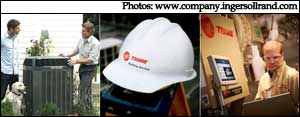 Historically, green construction has focused primarily on energy efficiency and waste reduction. Sudarshan S. Ananth, Territory Vice President and Business Head – HVAC & Transport, India Climate Business Unit, Ingersoll Rand India & SAARC, explains the ways to achieve the best possible energy efficiency with the lowest possible refrigerant emissions in building construction.
Historically, green construction has focused primarily on energy efficiency and waste reduction. Sudarshan S. Ananth, Territory Vice President and Business Head – HVAC & Transport, India Climate Business Unit, Ingersoll Rand India & SAARC, explains the ways to achieve the best possible energy efficiency with the lowest possible refrigerant emissions in building construction.
Increased affordability with access to loans and a rising population with rapid urbanisation are making construction one of the fastest growing sectors in India today. The downside is that it continues to deplete enormous natural resources—materials, water and substantial percentage of a nation’s energy footprint besides adding to growing urban waste. Clearly, drive for greener construction and sustainable habitat is gaining momentum and its scaling is the crying need of the hour.
Historically, green construction has been focused primarily on energy efficiency and waste reduction. Today, this concept has expanded to reflect a building’s sustainability, as well as its impact on improved indoor air quality, occupants’ health, comfort and productivity, and reduced embodied energy and water footprint besides lower operations and energy maintenance costs.
Green construction techniques are used to create homes and buildings that use resources in a sustainable way. These techniques range from choosing optimum usage of materials, use energy efficient methods, technology to minimise and recycle water usage, and designs that enhance indoor air quality.
Green construction benchmarks
There are many standards available in India to benchmark green construction in building projects. LEED NC is one such rating standard that examines the environmental impact associated with the construction and operation of buildings and infrastructure. Constructions with effective HVAC systems can be designed to significantly reduce energy consumption compared to conventional designs and practices and attain LEED certifications.
Leadership in Energy & Environmental Design (LEED) is a globally recognised green building rating, which provides building owners and operators with a framework for identifying and implementing practical and measurable green building design, construction, operations and maintenance solutions. Within each of the LEED credit categories, projects must satisfy prerequisites and earn points. The number of points the project earns determines its level of LEED certification. The relevant technical requirements with respect to HVAC systems for USGBC (US Green Building Council) LEED Rating are:
| Energy and atmosphere | 37 points |
| Indoor environmental quality | 17 points |
| Innovation and design process | 4 points |
In India, too, LEED-Rating through ‘India Green Building Council’ provides building owners, architects, consultants, developers, facility managers and project managers tools they need to design, construct and operate green buildings.
- Efficient, properly designed and sized HVAC equipment increases comfort and reduces energy costs for residents, reduces complaints for building owners and benefits the environment through reduced greenhouse gas emissions.
- Considering the entire building design when designing HVAC systems allows easier installation and maintenance, reduces resistance to airflow, and increases efficiency.
- Well sealed duct systems and proper filtration improve indoor air quality.
- Sealed and balanced systems improve air quality and safety by reducing the possibility of back drafting.
Efficient HVAC design
The HVAC industry over its 100 years of modern presence has been evolving to changing needs and requirements of the mechanically ventilated buildings. Efficient HVAC design makes a green construction, a high performance building and it all starts with right plant room equipment design, namely with the chiller selection. Selecting an environmentally friendly and energy efficient chiller is a key investment decision to creating green construction. Notable considerations for an efficient HVAC plant room include:
- Understanding role of appropriate refrigerants.
- Selecting the appropriate HVAC chiller technology.
From an environmental perspective, refrigerant usage in HVAC systems has several positive impacts:
Use of energy efficient and environmentally sensitive refrigerant can have a positive impact in reducing power consumption in a significant way. If every efficiency of centrifugal chiller is 0.50 vs. 0.60 KW/Ton, there is reduction in power requirement. Hence, consequence of emission reduction of coal-based power plant producing electricity annually will be around:
- 21 billion pounds of CO2
- 138 million pounds of SO
- 77 million pounds of NO
Often there are references of direct environmental impact being caused due to refrigerant leakage/release into the environment. ASHRAE (American Society of Heating, Refrigerating and Air-conditioning Engineers) recommends Guideline 3-1990 to reduce emissions of CFC refrigerants in refrigeration and air-conditioning equipment and applications. At Trane, we are extremely sensitive to this fact and have evolved a unique low pressure centrifugal technology based refrigerant usage that runs on ‘near zero’ emission.
Technology selection has to be based on overall cost of ownership. For the market that buys high efficiency chillers, Trane R-123 Chiller clearly stands out in terms of:
- Thermodynamic efficiency advantage of R-123.
- Direct drive compressor (no gear box); High reliable mechanical performance.
- Multiple-stage compressor (use of a flash economizer).
- Lowest emissions in its class of products with extremely low impact on global warming and ozone depletion.
- Heat exchangers manufactured using ASME Codes ensure better safety of the equipment and higher reliability.
 Holistic use of green technology
Holistic use of green technology
Several large builder and developer corporates are consciously building using green technology holistically, integrating “design to build and design to operate” to achieve best cost investment and optimum cost of operations. One key way this can be done since HVAC is one the largest power consumption areas in a building is by installing energy efficient and eco-friendly chiller along with chiller plant manager, a patent software having specific control strategies to optimise overall chiller plant energy efficiency along with providing preventive maintenance control. One of the pioneer developer groups, the Khivraj Group in Chennai, which is into information technology parks space, has built Olympia Technology Park, a Gold LEED Certification from USGBC. This project was conceived with HVAC system of eight air cooled Trane Chillers and Trane Plant Manager providing highest level of performance with lowest possible refrigerant emissions impact. Another such example is the Spectral Service Consultants corporate office in Noida, which is a USGBC Platinum Rated LEED Building. Trane met the platinum rating requirements for indoor environment quality through the use of variable air volume terminals throughout the building and Trane chiller for high efficiency and reliability.
Hence, in conclusion, design and planning to be a sustainable habitat and executing it well is the key to creating a high performing environmentally sensitive habitat. Considering that life of the HVAC chiller is, perhaps, as much as the life of the building, it would be noteworthy to remember that –
- Cost of energy to operate the chiller over a its lifecycle is as much as 95 per cent of the total lifecycle operation cost of a chiller
- The initial cost of the chiller is only a little more than 5 per cent than lifecycle cost of the chiller operation.
- When you are looking at refrigerant costs, the important factor is what it costs to add refrigerant that leaks over the life of the chiller. With average leakage rates of 0.5 per cent per year, the cost of additional refrigerant over the life of the chiller is only 0.04 per cent of the total lifecycle cost. Refrigerants with a higher pressure and resulting higher leakage rates will certainly be higher. Hence, low pressure technology chiller ensures minimum consumption of refrigerant.
Green building design has to be for lower emissions and high efficiency: this is the key focus for the future. Whether you are an equipment manufacturer, an engineer, or an owner, the focus of achieving the best possible energy efficiency, with the lowest possible refrigerant emissions is the key to being both environmentally and economically responsible.











